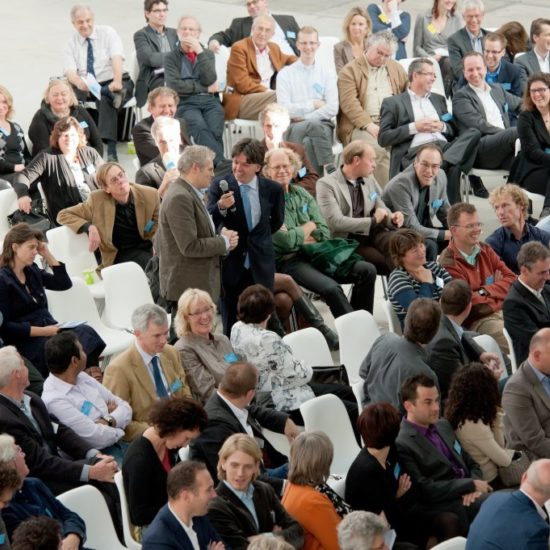Great content, inspiring speakers, a beautiful location, perfect catering and of course the best suited moderator ... they are all useless if the programme is badly designed.A good meeting design consists of a number of elements. In a series of articles we will deal with them one by one. This story is about: interaction and work formats.
We all know the examples: interaction for interaction's sake. When we suddenly find ourselves obliged to talk to someone, without knowing why. Or that we do a crazy dance, with fresh reluctance.
But it doesn't have to be like that. If interaction is well designed, everyone immediately feels the benefit. And then people are happy to participate.
Earlier, we discussed the why of interaction. Now we will look at the types of interaction. You can divide interaction into a few categories.
To start with, you can make a three-way split:
- from the podium with the audience.
- Between participants.
- Both at the same time.
You can then look at the purpose of the interaction. The list is long, but we will mention the most important ones:
- Gathering information: it can be important for a speaker to know what is going on in the audience. What do they already know, what are they struggling with, what are their needs, etc.? The participants may also need more information from each other. This can be factual information (how much, how long, how far...) or it can be softer emotional information.
- Ask questions. The most obvious form is the Q&A with a speaker. But beware: there are also many creative ways to give this another format than the well-known "are there any questions left". The participants can also ask each other questions.
- Getting to know each other: this is important to create a group feeling and safety. It is often the basis for a successful meeting.
- Help each other: Participants often have knowledge, acquaintances, information, skills etc. that others need. Interactive forms can help participants to help each other.
- Matchmaking: Apart from helping each other (see above) there are many other reasons why you bring people together. In practice, networking often does not rise to the level of a get-together. But with the right forms of interaction, networking can be of great value.
- Getting to the bottom of it: understanding a problem, situation or case is the basis of learning, deciding, changing etc. Interaction can help to put your finger on something, to evaluate or gain insight.
- Problem solving: An extension of understanding is solving problems and meeting challenges. This often works better in cooperation than alone.
- Decision making: sometimes a group needs to come to a decision together. Interactive working methods can ensure that the decision is reached more quickly and/or more effectively.
- Making agreements: this can be about establishing rules/procedures/direction, but also simply about plans/agenda.
- Brainstorming: this can only be effective if it is more than 'we all say something'. Good brainstorming requires well-designed working methods.
- Having fun: it is easier to have fun, when having it together. Using it well is the lubricant of any successful meeting.
- Celebrate: highlights & achievements only have value if you celebrate them, learn from them and build on them.
Once you have made this choice, you can start looking for the work format, group size and composition in which to cast it. There are literally millions of options for this, so it would go too far to name them all. What matters is that you always look for or design the format that best suits the goal and the moment of the day.
You can subdivide the forms of work into a few levels of interaction:
- Physical
- Mental
- Emotional
- Spiritual
- cultural
Conclusion
Interaction is more than just coming up with a nice format. It is about purpose, form and content that are used in a well-considered way.
Jan-Jaap In der Maur


